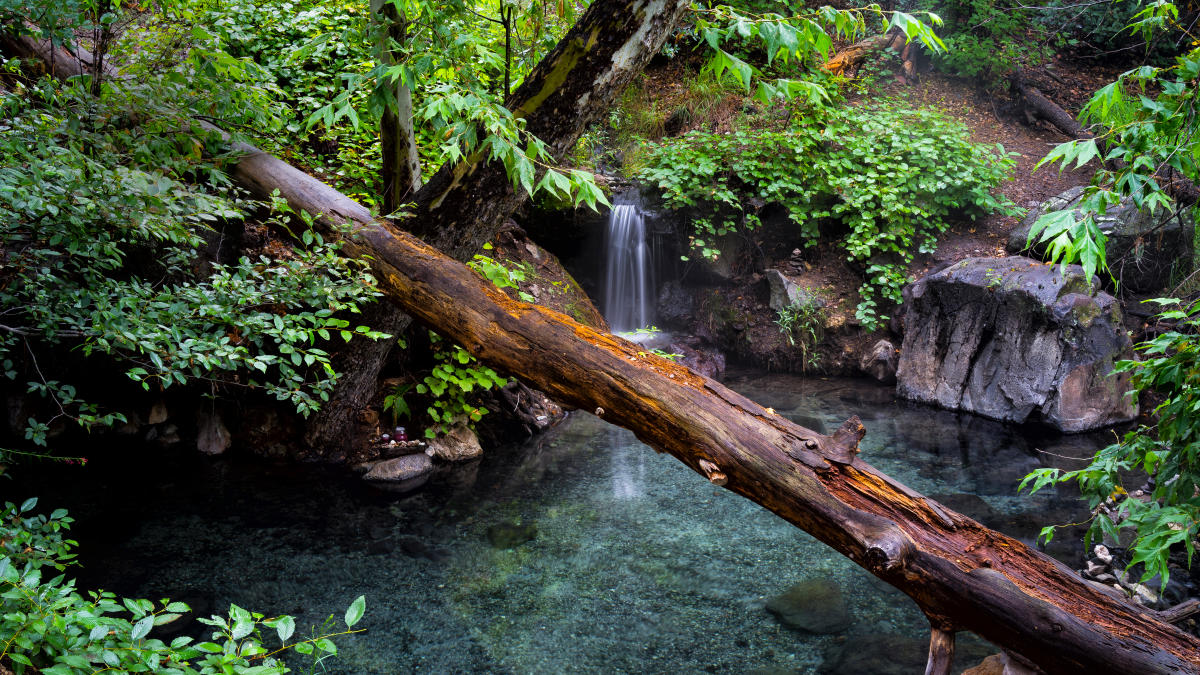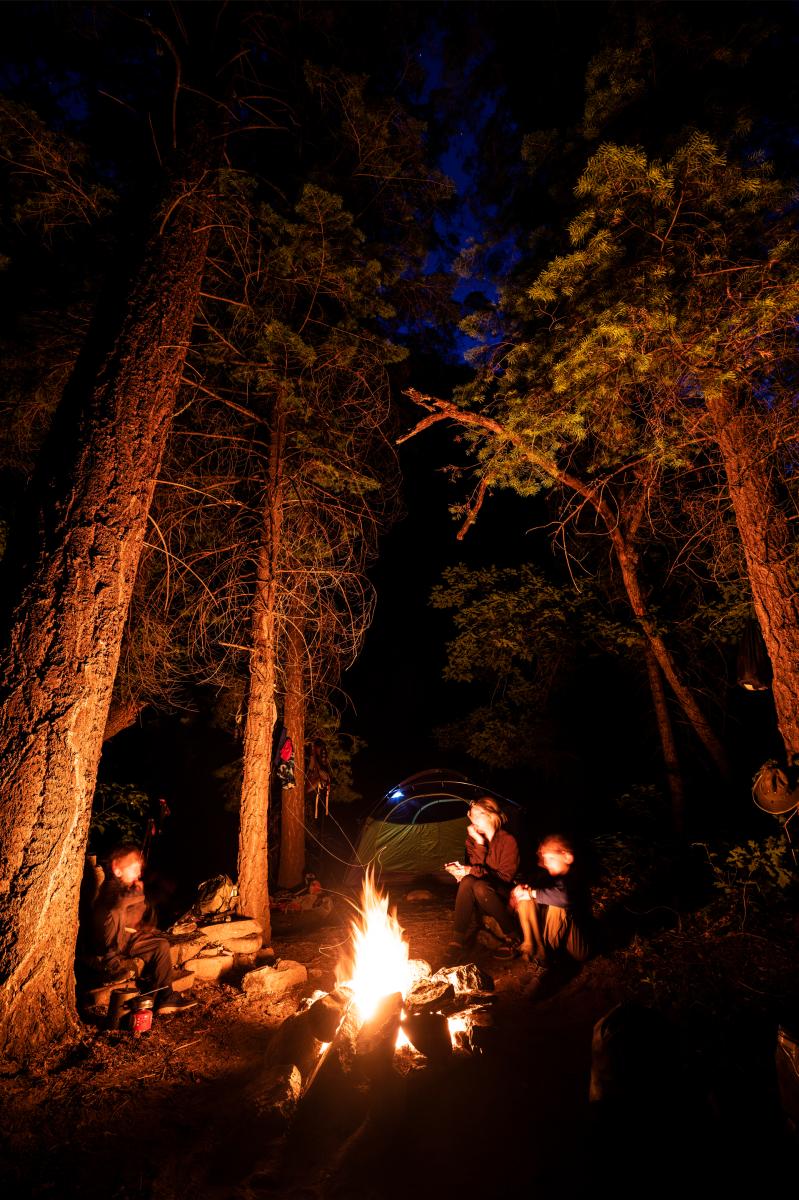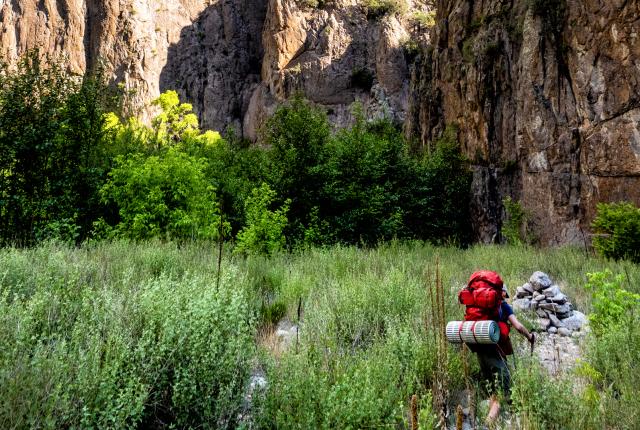A backpacker on a loop of the West and Middle Forks of the Gila River makes their way deeper into the wilderness.
THE FIRST MILES OF THE TRAIL wound among piñon, juniper, and Gambel oak, through a stretch where blackened trunks from an old wildfire spiked over a shadeless trail. The sun baked. Dust puffed up around our boots. Then the trail descended into a narrow slot canyon.
The sun counted out the hours of the afternoon across rock walls and rarely touched the bottom. Each step sank into dry sand, but above our heads, sticks and twigs wrapped around tree branches bent to point downcanyon by the rush of flash floods.
The evening before, my friend Brian and I had driven to the Gila National Forest, in southwestern New Mexico, the road winding past a flicker of cliffsides and pine boughs we couldn’t parse in the dark, before stumbling onto a campsite on a promontory off a random dirt road. The space around us could be felt in the uptick of wind as much as it could be seen in the blue-black dark. We rolled out our sleeping bags in the open and later awoke to find them covered in dew.
Fog filled the valley below, making an island out of a distant peak. But any hint of damp or chill burned away as the late-summer sun climbed into the sky, blazing over the agave and yucca around us. We drove on to a trailhead south of the Gila Cliff Dwellings National Monument, shouldered our backpacks, and headed for an overnight in a corner of the state we’d both barely begun to explore.
Brian and I had bonded over hiking in the high peaks, piecing together trails buried in deadfall and racing thunderstorms off alpine ridges. Often, that meant heading north or east from our homes in Santa Fe, but I’d spun the compass and wanted to try south and west. We’d found a window of not-quite-too-hot weather, but still warm enough that we could sleep comfortably without tents and watch the stars.
As we hiked deeper into the slot canyon, I watched as the sandy bottom began dampening in streaks. Then a puddle or two formed. Finally, a trickle of water pulled together. We followed it toward the Gila River, miles below. At a grove of cottonwood trees, the tiny tributary fell in line with the greater flow. The river ran below canyon walls split by cracks and fronted by a forest of pink, gray, and lichen-green stone pillars.
The moment begged for a pause. Like benches in front of massive paintings in a museum, the spread enticed a long look at the flourishes of color, the notes added by a change in texture, and the play of light over a surface. We lingered on a downed cottonwood trunk scraped bare of its rippling bark.
 A hot spring offers relaxing waters after a long day of hiking in the Gila National Forest.
A hot spring offers relaxing waters after a long day of hiking in the Gila National Forest.
When Aldo Leopold fought to create the nation’s first wilderness area—the most protective federal designation land can receive—he did so for the landscape we were walking into. The notion prompted a grand experiment to see what would happen if we stopped trying to plow or pave every inch of the woods. The Gila’s craggy, inhospitable geography primed it for this, but Leopold’s case applies on a much wider landscape.
“If the land mechanism as a whole is good, then every part is good, whether we understand it or not,” he wrote. “If the biota, in the course of aeons, has built something we like but do not understand, then who but a fool would discard seemingly useless parts? To keep every cog and wheel is the first precaution of intelligent tinkering.”
As these views have matured in the decades since, and as we’ve become more attuned to the Indigenous voices who first articulated these points, we’ve learned to appreciate the indispensability of a river to a canyon, and even of nature to ourselves. The words for this idea don’t sound poetic: interconnected, interdependent, symbiotic. But in summer, when we can eat in, drink from, and sleep out on the land, be governed by its light and dark hours, be shaped and directed by the water and wind just as the earth around us has been, we begin to feel our way into a place in that wider ecosystem.
Brian and I marveled as the canyon wound on, each turn shifting the view so that new outcroppings stood out from the wall or water pooled deep against a solid bank of rock. When the trail crossed the river, we pieced together a bridge of downed logs and rocks. At a deeper crossing, I unclipped sandals from my pack, tied my hiking boots in their place, rolled up my pant legs, and waded in. The water was wincing cold and knee-high, nudging us downstream. Numbed, we watched minnows scatter and frogs glide through the stiller waters.
The crossings rolled on. When the trail stayed on land, it meandered through tall grass and among cottonwoods, their leaves tilting in the breeze.
Farther downstream, the Gila River seems a tame trickle, warm and meandering through farmland in the Cliff-Gila Valley. But here, it’s like meeting the river’s wild ancestor, a rare, undammed stretch that, on some spring days, swells with melted snow to a force that reshapes pieces of the canyon.

A family enjoys their campfire after a day of backpacking in the Gila National Forest.
We’d planned to camp near a hot spring, but the directions relied on counting the number of times we forded the river. We struggled to keep track. Was that ten? Twelve? Then the trail turned to a mucky swamp. A beaten track marked a route uphill, which we followed and—there it is!—found a deep pocket of water tucked under the trees.*
At least one campsite sprawled nearby, but our setup could wait. We dropped our packs and headed into the bluish pool.
Warm water filled the gravel-bottomed basin, fed by a tiny, braided waterfall on one side and a seep that emerged among tangled roots and rocks on the other. The spring gurgled unseen through the jumble, rumbling like some faraway river. The water stilled to the point that stones in the alcove reflected so clearly on its surface they could baffle the eye into believing they lay below.
A few crisp leaves dropped from the overhanging trees and floated for a moment, rehydrating then sinking. We lingered for hours longer than I’d expected, close enough to each other that we could murmur our conversation, respecting other soakers’ privacy.
As the sun moved closer to the canyon rim, the water seemed to cool. We dried off among the junipers and hiked to the ridgeline behind the spring. On a thin strip of packed earth, our sleeping bags fit rolled out side by side.
The last light peeled away from the tops of the canyon walls and we began to watch for stars to fall. Each meteor drew its own streamer, brief trickles in the darkness. A massive moon rose, bright on the rocky ribs and ridges around us, filling the sky with its own kind of flood.
*High-use rates around hot springs can degrade their delicate ecology. Visit with care and only set up camp on the far side of the river.

CHANGE YOUR PACE
Consider not only mixing up where you explore but how you do it. “Think about using different modes to experience our state,” says Joshua Arnold, avid cyclist and owner of Routes Bicycle Tours & Rentals. Work a hike into your next road trip. Ride a horse. You’ll be surprised what you discover with a change of pace and perspective.


